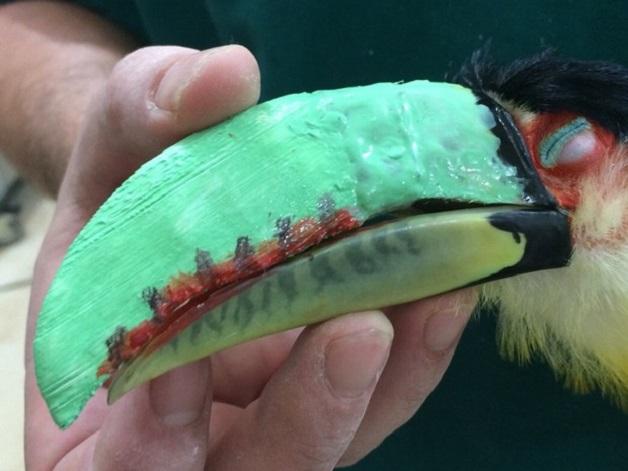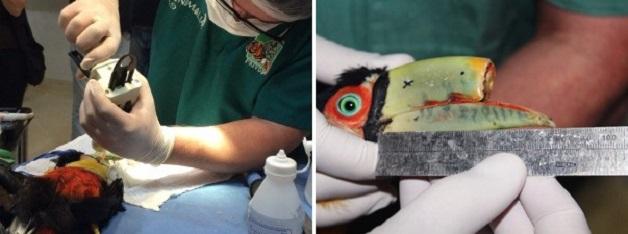 It was just a couple of days ago that we reported on an amazing story in which a white pelican recieved a 3D printed beak. This wasn’t the first case of an animal given a second chance on life, thanks to 3D printing, and it certainly won’t be the last.
It was just a couple of days ago that we reported on an amazing story in which a white pelican recieved a 3D printed beak. This wasn’t the first case of an animal given a second chance on life, thanks to 3D printing, and it certainly won’t be the last.
Now, one group of researchers in Jundiaí, São Paulo, Brazil have created a 3D printed prosthetic beak for a green-billed toucan. The toucan, who broke off the majority of his upper beak after flying into a window of a building, was left unable to eat. Without human aided feeding provided to the toucan from veterinarians, he would have starved to death.
“This toucan could not eat, so if we did not do the operation he literally starve to death,” explained veterinarian Roberto Fecchio. “We had to think of something to help him. It is voluntary work involving many people, a multidisciplinary team and we are learning too along the way.”
Brazil is one of the more noted countries when it comes to using 3D printing technology in the medical field. While most of the stories we hear coming from the country involve human patients, we’ve also seen a few instances where the technology has led to a more fulfilling life for animals as well. This latest one, may just top them all though.
Using photogrammetry, technicians were able to replicate the portion of the beak, and then turn it into a 3D model. Using special modeling software, the beak was able to be hollowed and manipulated exactly how they wanted, prior to 3D printing it on an FDM/FFF based 3D printer out of PLA plastic. This was the second attempt at finding a solution for the bird.
“We first tried by using a prosthesis that was taken from the corpes of another toucan, but it broke,” explained Paul Miamoto, an expert inn forensic dentistry. “It’s hard to find the exact size and species, for a match.”
Planning for the surgery took just about two weeks, and the surgery lasted just about an hour. Surgeons were able to successfully attached the 3D printed beak to the remaining portion of the bird’s original beak. Not long after the surgery, the bird was right back to eating normally again, allowing him to lead an ordinary life.
“It is the first for a toucan in Brazil, and I can even risk saying it is the first in the world,” said Fecchio. “We are just at the beginning with this type of technology. The toucan, for example, began to eat right away, which shows that the operation was a success, and we are now monitoring developments in the coming weeks.”
This is just another phenomenal case of an animal being saved thanks to the benefits offered by 3D printing technology. What do you think about this latest instance? Discuss at 3DPB.com.
Subscribe to Our Email Newsletter
Stay up-to-date on all the latest news from the 3D printing industry and receive information and offers from third party vendors.
You May Also Like
Precision at the Microscale: UK Researchers Advance Medical Devices with BMF’s 3D Printing Tech
University of Nottingham researchers are using Boston Micro Fabrication‘s (BMF) 3D printing technology to develop medical devices that improve compatibility with human tissue. Funded by a UK grant, this project...
3D Printing Webinar and Event Roundup: April 21, 2024
It’s another busy week of webinars and events, starting with Hannover Messe in Germany and continuing with Metalcasting Congress, Chinaplas, TechBlick’s Innovation Festival, and more. Stratasys continues its advanced training...
3D Printing Webinar and Event Roundup: March 17, 2024
It’s another busy week of webinars and events, including SALMED 2024 and AM Forum in Berlin. Stratasys continues its in-person training and is offering two webinars, ASTM is holding a...
3D Printed Micro Antenna is 15% Smaller and 6X Lighter
Horizon Microtechnologies has achieved success in creating a high-frequency D-Band horn antenna through micro 3D printing. However, this achievement did not rely solely on 3D printing; it involved a combination...

































